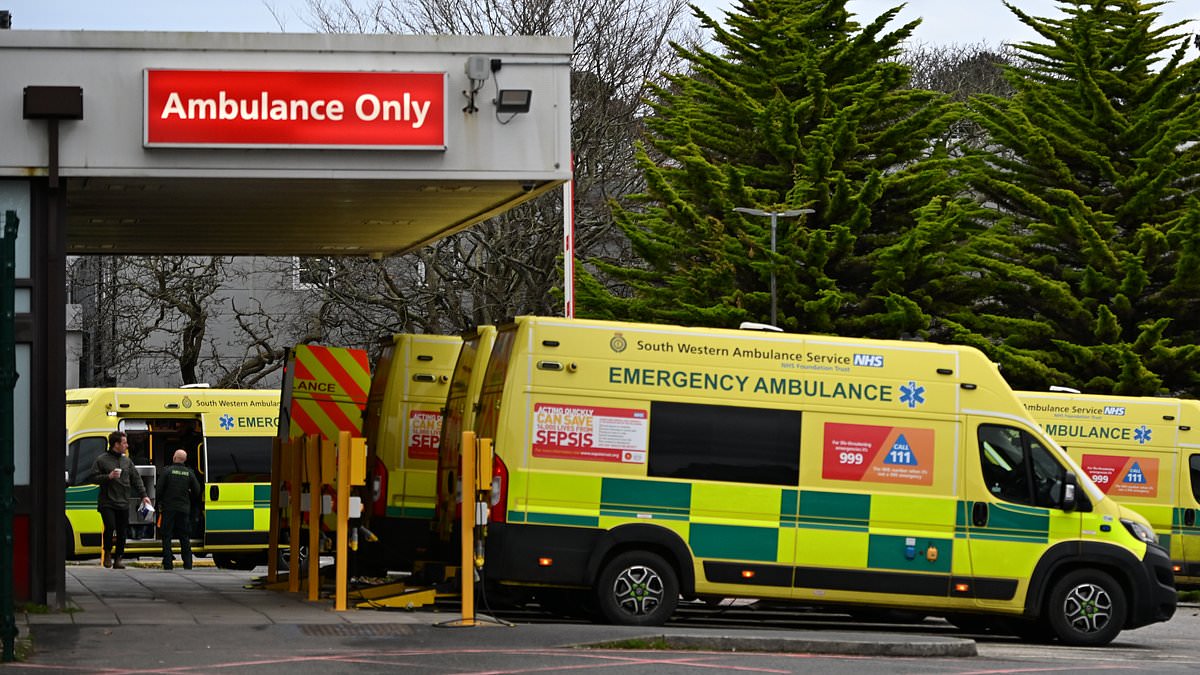England’s emergency services are battling their ‘busiest winter ever’ as flu cases continue to soar, health chiefs warned today.
More than 2.3million patients visited A&E in December while ambulance teams tackled over 800,000 incidents — the highest number ever recorded in a single month.
Separate surveillance data that monitors England’s flu outbreak also suggests hospital admissions are up a fifth in a week and nearly five times the level recorded in early December.
Figures show more than 5,400 beds alone were taken up by flu patients every day last week, up 3.5 times on the same week last year.
Of these, 254 were in critical care — up a fifth on the previous week.
Rates of the winter vomiting bug norovirus, meanwhile, are almost 50 per cent higher than expected for this time of year.
England’s top doctor today warned that NHS staff were under ‘intense pressure’ and faced a situation ‘similar to the days at the height of the pandemic’.
Health leaders also said the ‘unacceptable conditions’ facing patients were a result of ‘Government ignorance’ and cautioned that nursing staff had ‘never been more worried for patient safety’.

The crisis has already led to a dozen hospitals declaring critical incidents meaning they are struggling to provide safe care to patients.
Experts also fear the UK’s ‘dangerous’ cold spell will continue to pile pressure on already stretched hospitals.
Just this week the UK Health Security Agency extended its ‘amber’ cold-health alert, until 12pm Sunday January 12. The previous alert was due to expire yesterday.
Professor Sir Stephen Powis, NHS National Medical Director, said: ‘It is clear that hospitals are under exceptional pressure at the start of this new year, with mammoth demand stemming from this ongoing cold weather snap and respiratory viruses like flu.
‘All on the back of 2024 being the busiest year on record for A&E and ambulance teams.
‘I never fail to be impressed by the remarkable job that NHS staff across a range of services in the face of current challenges, remaining compassionate, professional and doing everything they can to see patients as quickly as possible while often working in hospitals that are full to bursting.
‘It is hard to quantify just through the data how tough it is for frontline staff at the moment — with some staff working in A&E saying that their days at work feel like some of the days we had during the height of the pandemic.
‘As the incredibly busy winter continues and hospitals clearly experience intense pressure, please do continue to only use 999 and A&E in life-threatening emergencies.’

Multiple NHS hospitals have now declared ‘critical incidents’. Pictured, ambulances wait outside the emergency department at the Royal Cornwall Hospital on January 4

NHS national medical director, Professor Sir Stephen Powis, today warned that NHS staff were under ‘intense pressure’ and faced with a situation ‘similar to the days at the height of the pandemic’
Royal College of Nursing general secretary and chief executive professor Nicola Ranger also warned: ‘Nursing staff have never been more worried for patient safety.
‘As flu cases soar, sick and vulnerable people are lining corridors, whilst many hospitals are declaring critical incidents.
‘This is the brutal reality in an NHS which has too few beds, not enough staff and nowhere to discharge patients to.
‘The tragedy is this situation is not new, with these unacceptable conditions now seen all year round.
‘Nursing staff have repeatedly called for investment in social care and community services to ease the pressure on hospitals, but successive governments ignored them.
‘Today’s scenes on wards are a consequence of that ignorance.’
Professor Phil Banfield, chairman of the British Medical Association, said the NHS is in a ‘national emergency’.
‘Doctors and patients are being left to face situations they simply should not have to: patients needing urgent care left in corridors for hours on end, often in unsanitary conditions.
‘The entrance to the NHS can’t be fixed if the exits aren’t working; the crush in the middle is a living nightmare for too many patients currently. Doctors are unable to give the care we want.’
But health and social care secretary, Wes Streeting added: ‘Despite the best efforts of staff, patients are still receiving unacceptable standards of care.
‘Although this winter’s campaign vaccinated more people than last winter, this strain of flu has hit hard, putting more than three times as many patients into hospital compared to this time last year.

Graphic shows the common symptoms (green tick), occasional and possible symptoms (orange circle) and the symptoms that never occur (red cross) with the common cold, flu and Covid
‘Annual winter pressures should not mean an annual winter crisis, which is why this government is making significant investment in the NHS, undertaking fundamental reform, and acting now to improve social care.
‘It will take time to turn the NHS around, but the fact that waiting lists are now falling shows that change is possible.’
According to the latest NHS weekly figures there were an average of 5,408 flu patients in hospital in England every day last week.
By comparison, the figure stood at 1,548 over the same period last year. It is slightly lower, however, than this point two years ago.
More than 620 hospital beds in England were also filled each day last week by patients with diarrhoea and vomiting or norovirus-like symptoms.
This is up almost a fifth on the 528 in the previous week and almost 50 per cent on the same point last year (424).
RSV — which is most common in infants and young children — was up almost half on the same period in 2023.
More than 1,100 beds were also occupied by patients with Covid.
Some hospitals have begun to limit visiting hours and have imposed mask mandates over fears of rising ‘quad-demic’ cases.
At least a dozen have also now declared ‘critical incidents’.
These include South Warwickshire University NHS Trust, University Hospitals Birmingham NHS Foundation Trust, Hampshire Hospitals NHS Foundation Trust, University Hospitals Plymouth NHS Trust, and the The University Hospitals of Northamptonshire.
Critical incident is an NHS term that’s used by hospitals when they can no longer guarantee that patient care can be delivered safely.
Such incidents are typically declared in response to overwhelming demand or infrastructure failure.
The NHS data also showed more than 4 in 10 patients arriving by ambulance to hospitals in England last week waited at least half an hour to be handed over to A&E teams — the highest figure so far this winter.
More than a fifth of handovers — 19,554 patients — were delayed by more than an hour, again the highest figure so far this winter and almost double the same point last year.
Separate ambulance figures for December released by the health service today, also found response times had slumped.

Norovirus can appear similar the symptoms of Covid, with both viruses causing chills, fever and headaches
Heart attack and stroke patients in England, known as category two callers, had to wait an average of 47 minutes and 26 seconds for paramedics to arrive on the scene.
This is five minutes slower than November and two and a half times as long as the 18 minute target.
The average category one response time — calls from people with life-threatening illnesses or injuries — was 8 minutes and 40 seconds. This is just 2 seconds longer than the previous month. The target time is seven minutes.
Ambulance teams handled more than 806,000 incidents in December taking the total number for 2024 to 8.94million — up more than 600,000 on 2023.
Meanwhile, NHS England monthly A&E performance data released today shows over 54,000 attendees in December had to wait more than 12 hours before being admitted, transferred or discharged.
Some 71 per cent of patients were seen within four hours — the health service’s target is 95 per cent.
But these figures only look at trolley waits — the time between doctors deciding a patient needs to be admitted and them getting a bed.
Figures capturing exact arrival times at A&E paint a much bleaker picture, with 166,989 patients (12 per cent) forced to wait at least 12 hours.

Royal Bolton Hospital is one of those asking all staff, patients and visitors to wear a mask to combat a surge in winter pathogens like flu
This is up almost 10,000 on the 157,556 recorded in November 2024.
Experts today warned Brits were ‘doomed to witness the same scenario for the forseeable future’ and criticised Government plans to reduce the NHS waiting list given the ‘crisis in emergency care’.
Known as the ‘Elective Reform Plan’, it has pledged to diagnose and treat 92 per cent of patients within 18 weeks of receiving a referral from a GP by the end of this Parliament.
This has been an official NHS target for some time but has not been met since 2015.
The new promise is to reach 65 per cent by March 2026 — which, according to the government, would reduce the backlog by more than 450,000.
NHS waiting list data, released today, showed the overall list had fallen to its lowest level since May 2023.
An estimated 6.28 million people were waiting for 7.48 million treatments at the end of November.
More than 2,000 patients had been stuck for more than 18 months to start treatment, while almost 17,000 had been left over 65 weeks.

The ‘Elective Reform Plan’ has pledged to diagnose and treat 92 per cent of patients within 18 weeks of receiving a referral from a GP by the end of this Parliament. Pictured, Keir Starmer unveiling the plan on Monday
The target to eliminate all waits of more than 65 weeks was September 2024.
Dr Tim Cooksley, immediate past president of the Society for Acute Medicine, said: ‘The reality for patients and staff is corridors full of patients experiencing degrading care, being treated in the backs of ambulances because there is simply no space in hospital and the immense physical and emotional harm that inevitably results.
‘This was predictable and inevitable given that hospitals were bursting at the seams before the “quad-demic” of winter viruses hit.
‘The fundamental issue is that there is a continued lack of capacity throughout the year: a tough flu season must not be used as a political excuse for the current situation.
‘Its foundations are much deeper and unless we address those, we are doomed to witness the same scenario for the foreseeable future.
‘It is also deeply flawed to believe we can deliver an elective recovery whilst there remains a crisis in urgent and emergency care.
‘We must now address these issues of capacity and workforce. They are not quick to do so. The need to start that journey now is imperative.
‘Artificial quick wins are failing and will inevitably continue to do so.’
Sarah Arnold, senior policy lead at The King’s Fund, added: ‘Extreme pressures in A&E are the bellwether for a health care system that is under intense strain.
‘Throughout the year, NHS services are run worryingly close to full capacity, and spikes in demand for care when cold weather, flu or other seasonal pressures hit can be catastrophic.’
Proposals by the Government to reduce 18-week waits ‘have been achieved before in the 2000s’, she added.
‘However, the circumstances back then are quite different to today and the overall waiting list was just over half of what it is now.
‘In 2023-24, only one third of NHS trusts made any improvement at all in the percentage of patients seen within 18 weeks.
‘So far in 2024-25 more than four in ten (42 per cent) have not made any improvements.’










